Country
code
NJ
Crash of a Piper PA-31-350 Navajo Chieftain in Burlington: 9 killed
Date & Time:
Aug 9, 2000 at 0752 LT
Registration:
N27944
Survivors:
No
Schedule:
Lakehurst - Patuxent
MSN:
31-7952056
YOM:
1979
Crew on board:
2
Crew fatalities:
Pax on board:
7
Pax fatalities:
Other fatalities:
Total fatalities:
9
Captain / Total hours on type:
1418.00
Circumstances:
A Piper PA-31-350 Navajo Chieftain, N27944, operated by Patuxent Airways, Inc., Hollywood, Maryland, and a Piper PA-44-180 Seminole, N2225G, operated by Hortman Aviation Services, Inc., Philadelphia, Pennsylvania, were destroyed when they collided in flight over Burlington Township, New Jersey. The airline transport pilot, commercial pilot, and seven passengers aboard the Navajo Chieftain were killed, as were the flight instructor and the private pilot aboard the Seminole. Day visual meteorological conditions existed at the time of the accident, and both airplanes were operating under visual flight rules when the collision occurred. The flight crews of both airplanes were properly certificated and qualified in accordance with applicable Federal regulations. None of these individuals was experiencing any personal problems or rest anomalies that would have affected their performance. The airplanes had undergone the required inspections. Examination of their maintenance documents revealed that both airplanes complied with all appropriate airworthiness directives. Evidence gathered from the wreckage indicated that neither airplane had experienced an in-flight fire, bird strike, or structural or mechanical failure. Tissue samples revealed that the pilot of the Seminole had taken doxylamine sometime before the accident. (Doxylamine is a sedating antihistamine that has substantial adverse effects on performance.) However, the amount of blood available for analysis was insufficient for determining exactly when the pilot may have ingested the medication or whether his performance was impaired by the effects of doxylamine. A partial cockpit visibility study revealed that the Seminole would have been visible to the pilots in the Chieftain for at least the 60 seconds before the collision. No stereo photographs from a Seminole cockpit were available to determine precise obstruction angles. However, because of the relative viewing angle, the Chieftain would have been visible to the pilots in the Seminole for most of the last 60 seconds. The study further revealed that about 4 seconds before impact, or about .11 nm separation, the angular width of each airplane in each pilot's field of vision would have been approximately 0.5 to 0.6 degrees or about 1/4 inch apparent size at the windscreen.
Probable cause:
The failure of the pilots of the two airplanes to see and avoid each other and maintain proper airspace separation during visual flight rules flight.
Final Report:
Ground accident of a McDonnell Douglas MD-81 in Newark
Date & Time:
Jun 14, 2000 at 1700 LT
Registration:
N16884
Survivors:
Yes
Schedule:
Newark - Detroit
MSN:
48074
YOM:
1981
Flight number:
CO481
Crew on board:
1
Crew fatalities:
Pax on board:
6
Pax fatalities:
Other fatalities:
Total fatalities:
0
Aircraft flight hours:
45834
Aircraft flight cycles:
36189
Circumstances:
The aircraft was parked at gate C115 awaiting for passengers on a flight (service CO481) from Newark to Detroit-Wayne County Airport. In unclear circumstances, a pilot attempted to make an engine run test while six employees were cleaning the cabin. The aircraft moved forward and collided with the main terminal, suffering major structural damages. There were no injuries among the seven occupants while the aircraft was damaged beyond repair.
Probable cause:
No investigations were conducted by NTSB on this event.

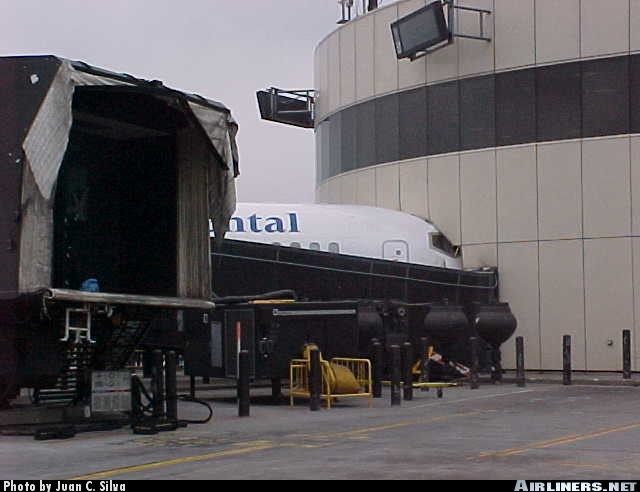
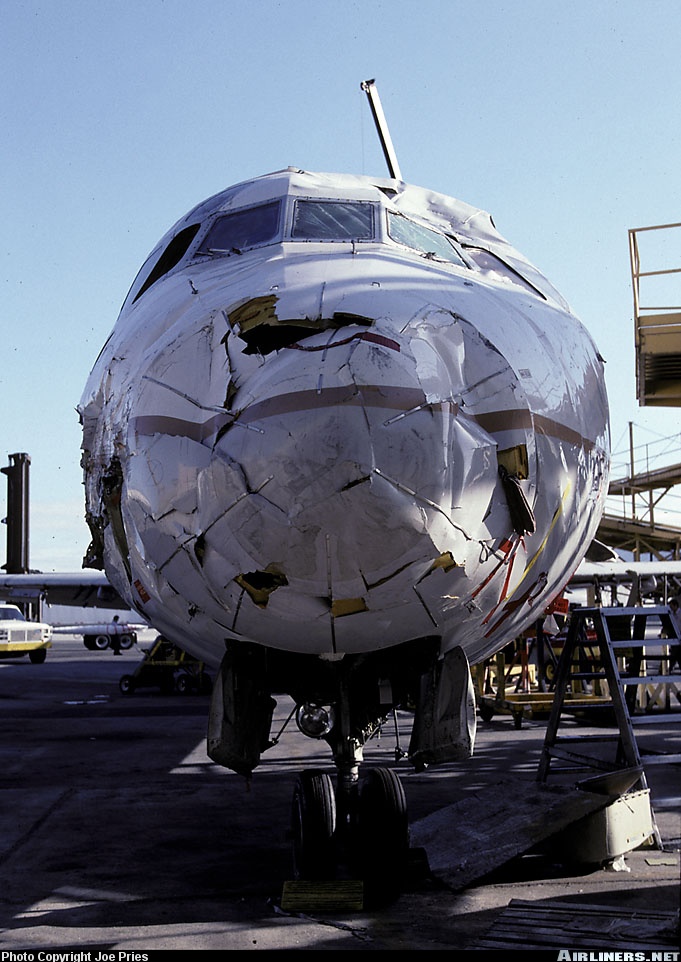
Crash of a Cessna 401B in Caldwell
Date & Time:
Oct 2, 1999 at 0751 LT
Registration:
N88VA
Survivors:
Yes
Schedule:
Caldwell - South Bend
MSN:
401-0118
YOM:
1968
Crew on board:
1
Crew fatalities:
Pax on board:
7
Pax fatalities:
Other fatalities:
Total fatalities:
0
Captain / Total hours on type:
118.00
Aircraft flight hours:
4686
Circumstances:
The pilot aborted the takeoff run after the airspeed indication rose to about 80 miles per hour, but would not go any higher. He could not stop the airplane, before it went off the end of the runway, over a berm, and into a drainage ravine. When the airplane was pulled out of the ravine, both pitot covers were still in place, around the pitot tubes. The runway was 4,553 feet long, calculated takeoff distance was about 2,525 feet, and calculated accelerate-stop distance was approximately 2,950 feet. Tire skid marks started around 3,600 feet from the approach end of the runway, and led to the wreckage. About a year earlier, another airplane was destroyed when it ran into the same ravine, which was located about 200 feet from the end of the runway.
Probable cause:
The pilot's inadequate preflight, which resulted in an attempted takeoff with the pitot covers installed. An additional cause was the pilot's delayed decision to abort the takeoff, while factors included the misleading airspeed indications, and the proximity of the drainage ravine to the end of the runway.
Final Report:
Crash of a McDonnell Douglas MD-11F in Newark
Date & Time:
Jul 31, 1997 at 0131 LT
Registration:
N611FE
Survivors:
Yes
Schedule:
Singapore – Penang – Taipei – Anchorage – Newark
MSN:
48604
YOM:
1993
Flight number:
FDX014
Crew on board:
3
Crew fatalities:
Pax on board:
2
Pax fatalities:
Other fatalities:
Total fatalities:
0
Captain / Total hours on type:
1253.00
Copilot / Total hours on type:
95
Aircraft flight hours:
13034
Aircraft flight cycles:
2950
Circumstances:
The aircraft crashed while landing on runway 22R at Newark International Airport (EWR), Newark, New Jersey. The regularly scheduled cargo flight originated in Singapore on July 30 with intermediate stops in Penang, Malaysia; Taipei, Taiwan; and Anchorage, Alaska. The flight from Anchorage International Airport (ANC), Anchorage, Alaska, to EWR was conducted on an instrument flight rules flight plan and operated under provisions of 14 Code of Federal Regulations (CFR) Part 121. On board were the captain and first officer, who had taken over the flight in Anchorage for the final leg to EWR, one jumpseat passenger, and two cabin passengers. All five occupants received minor injuries in the crash and during subsequent egress through a cockpit window. The airplane was destroyed by impact and a post crash fire. According to flight plan and release documents, the airplane was dispatched to ANC with the No. 1 (left engine) thrust reverser inoperative. The flight plan time from ANC to EWR was 5 hours and 51 minutes—47 minutes shorter than the scheduled time of 6 hours and 38 minutes because of 45-knot tailwinds en route. The flight crew stated that at flight level (FL) 330 (about 33,000 feet mean sea level [msl]), the flight from ANC to EWR was routine and uneventful. At 0102:11, a Federal Aviation Administration (FAA) Boston Air Route Traffic Control Center air traffic controller instructed flight 14 to descend and maintain FL180, according to the airplane’s cockpit voice recorder (CVR). About 0103, the captain and first officer discussed the approach and landing to runway 22R and the airplane’s landing performance. Using the airport performance laptop computer (APLC), the first officer determined that the airplane’s runway stopping distance would be approximately 6,080 feet using medium (MED) autobrakes. According to the CVR, at 0103:33, the flight crew then compared the APLC approximate landing distance for MED braking (6,080 feet) to the after-glideslope touchdown distance (6,860 feet) provided on the instrument approach plate. Based on the flight crew's calculation (6,860 – 6,080), MED braking provided a 780-foot margin after stopping. The flight crew then compared the APLC approximate landing distance for maximum (MAX) braking (5,030 feet) to the same 6,860-foot after-glideslope touchdown distance provided on the instrument approach plate. Based on the flight crew's calculation (6,860 – 5,030), MAX braking provided a 1,830-foot margin after stopping. On the basis of these calculations, the first officer suggested using MAX autobrakes. The captain agreed, stating “we got a lot of stuff going against us here so we’ll…start with max.” The first officer added, “I mean…I mean if we don’t have the reverser.” At 0114:22, the captain asked the first officer to advise the passengers that “we’re gonna have a pretty abrupt stop because of those brakes and the thrust reversers and all that stuff.” Twice during the approach, the captain asked the first officer to remind him to only use the No. 2 and No. 3 thrust reversers. At 0116:16, the captain noted that the left landing light was inoperative, adding “… just the right’s working.” The EWR tower controller cleared flight 14 to land at 0129:45 and advised the flight crew “winds two five zero at five.” At 0130:02, the first officer stated “max brakes” during the before-landing checklist. The captain replied “max brakes will be fine,” and the first officer responded “if they work.” At 0130:34, the captain stated “[landing gear] down in four green” and called for “flaps fifty.” At 0130:45, the captain disengaged the autopilot at an altitude of 1,200 feet during the approach and “hand flew” the airplane to touchdown. The autothrottles were engaged, as recommended by McDonnell Douglas and FedEx procedures. According to information from the airplane’s flight data recorder (FDR), the approach was flown on the glideslope and localizer until touchdown, and the airplane’s approach airspeed was about 158 knots until the flare. According to the CVR, the pilots had selected an approach reference speed of 157 knots, or Vref plus 5 knots. Altitude callouts were made by the on board central aural warning system (CAWS) at 1,000 feet and 500 feet, and the first officer called out minimums (211 feet) at 0132:03. At 0132:09, the first officer stated “brakes on max,” and CAWS callouts followed for 100, 50, 40, 30, 20, and 10 feet until the sound of initial touchdown at 0132:18.75. One-half second later, the CVR recorded an expletive by the captain. At 0132:20.26, the CVR recorded increasing high-frequency tones consistent with engine spool-up (accelerating engine rpms), and at 0132:21.06, the CVR recorded a decrease in high-frequency tones consistent with engine spool-down. The sound of a “loud thump” consistent with another touchdown was recorded at 0132:21.62. A series of expletives by the captain and first officer followed until sounds of “metallic breakup” were recorded at 0132:27. FDR data indicated that after the airplane’s initial touchdown, it became airborne and rolled to the right as it touched down again (see section 1.1.1 for a detailed description of the airplane’s performance during the landing sequence). The airplane continued to roll as it slid down the runway, coming to rest inverted about 5,126 feet beyond the runway threshold and about 580 feet to the right of the runway centerline. The accident occurred during the hours of darkness. Visual meteorological conditions prevailed at the time of the accident.
Probable cause:
The captain’s overcontrol of the airplane during the landing and his failure to execute a go-around from a destabilized flare. Contributing to the accident was the captain’s concern with touching down early to ensure adequate stopping distance.
Final Report:


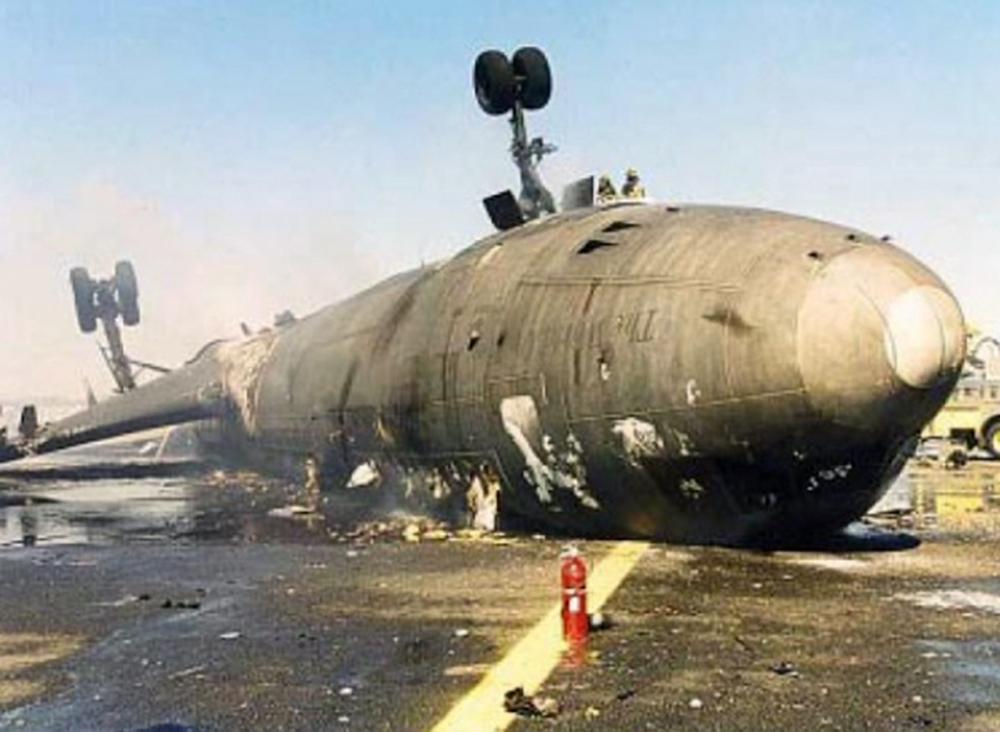
Crash of a Boeing 727-227 in Newark
Date & Time:
Jun 7, 1997
Registration:
N571PE
Survivors:
Yes
MSN:
21264
YOM:
1976
Crew on board:
2
Crew fatalities:
Pax on board:
0
Pax fatalities:
Other fatalities:
Total fatalities:
0
Circumstances:
The aircraft was transferred from the maintenance facilities to the main terminal by a technical crew when control was lost. The airplane collided with the USAir Terminal and the cockpit was destroyed.
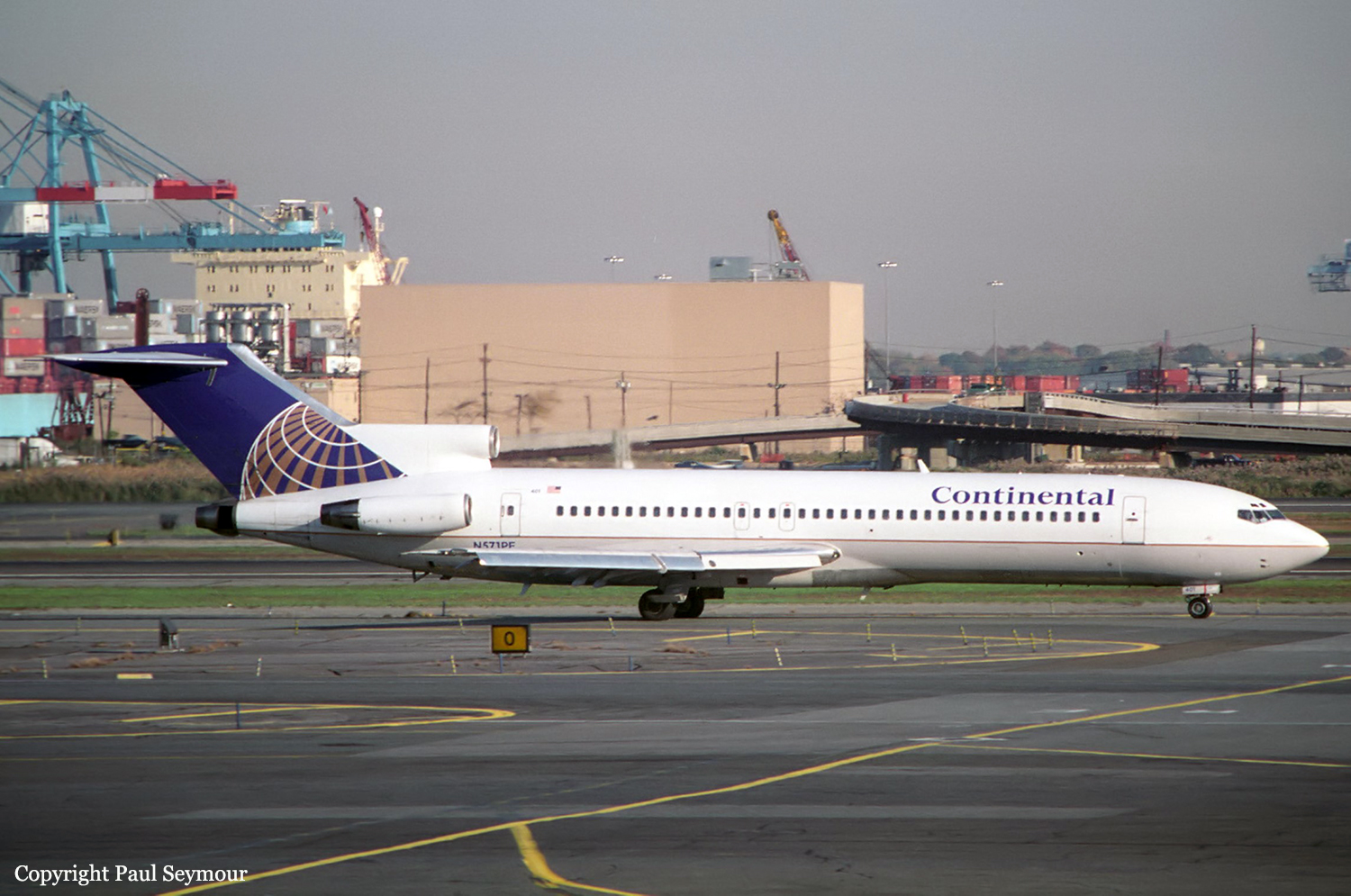

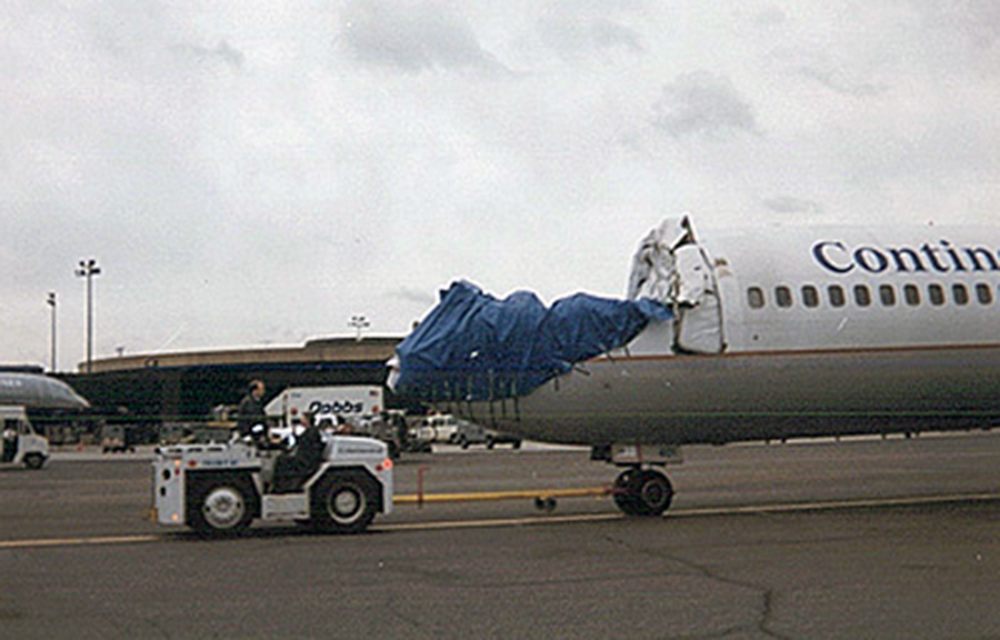
Crash of a Piper PA-61P Aerostar (Ted Smith 601P) off Sea Isle City: 4 killed
Date & Time:
Aug 14, 1994 at 2303 LT
Registration:
N3642A
Survivors:
No
Schedule:
Myrtle Beach – Oxford
MSN:
61-0823-8063432
YOM:
1980
Crew on board:
1
Crew fatalities:
Pax on board:
3
Pax fatalities:
Other fatalities:
Total fatalities:
4
Circumstances:
While in cruise flight in a level six thunderstorm over the Atlantic Ocean, the pilot reported the airplane's 'gyro' had failed. The airplane then began a left turn and disappeared off radar. The airplane and its occupants were located on the ocean floor about 48 days after the accident. The airplane had broken apart in-flight. The outboard section of each wing and the tail section were not recovered. The airplane's pneumatic system was destroyed. According to fss records, the pilot had been briefed on the weather along his route of flight.
Probable cause:
The pilot's failure to maintain aircraft control. Factors contributing to the accident were the presence of a level 6 thunderstorm, loss of gyro's for an undetermined reason, and the pilot's poor weather evaluation.
Final Report:
Crash of a Travel Air 4000 in Marlboro: 2 killed
Date & Time:
Aug 7, 1993 at 1850 LT
Registration:
NC365M
Survivors:
Yes
Schedule:
Marlboro - Marlboro
MSN:
1297
Crew on board:
1
Crew fatalities:
Pax on board:
2
Pax fatalities:
Other fatalities:
Total fatalities:
2
Captain / Total hours on type:
336.00
Aircraft flight hours:
6276
Circumstances:
This flight was the ninth sightseeing flight of the day for this airplane and pilot. No problems had been reported on the earlier flights. After takeoff and at an altitude of approximately 150 feet, the engine lost power and it began to sputter. The pilot initiated a left turn to land on a field north of the airport. During this turn, the pilot lost control of the airplane, and it impacted the ground in a nose low attitude. A post-impact fire destroyed the airplane and severely burned the engine. An examination of the engine revealed no discrepancies. The pilot was seriously injured while both passengers were killed.
Probable cause:
The loss of engine power for undetermined reasons, and the pilot's failure to maintain adequate airspeed, which resulted in an inadvertent stall and inflight collision with the terrain.
Final Report:
Crash of a Cessna 414A Chancellor in Atlantic City: 1 killed
Date & Time:
Nov 23, 1990 at 2135 LT
Registration:
N2693F
Survivors:
No
Schedule:
Wilmington - Atlantic City
MSN:
414A-0423
YOM:
1979
Crew on board:
1
Crew fatalities:
Pax on board:
0
Pax fatalities:
Other fatalities:
Total fatalities:
1
Circumstances:
The pilot was approaching Atlantic City Airport by night and poor weather conditions when the twin engine aircraft struck the ground and crashed few miles short of runway. The aircraft was destroyed and the pilot, sole on board, was killed.
Probable cause:
Failure of the pilot to follow the published ILS procedure and his continued descent below the decision height. Darkness and the adverse weather conditions were related factors.
Final Report:


